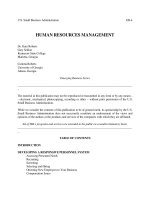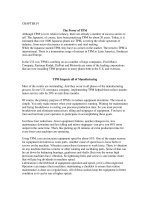Tài liệu E-Human Resource Management 32 pdf
Bạn đang xem bản rút gọn của tài liệu. Xem và tải ngay bản đầy đủ của tài liệu tại đây (689.58 KB, 9 trang )
Managing and Practicing OD in an IT Environment 265
Copyright © 2005, Idea Group Inc. Copying or distributing in print or electronic forms without written
permission of Idea Group Inc. is prohibited.
adaptations, result in far greater effectiveness and organizational impact in IT
projects. With hundreds of billions of dollars in waste being chalked up each
year, IT projects are going to face increasing scrutiny before they are started
and throughout their life cycles. With some incremental change, IT can continue
its growth with less of the burden of failure it bears today.
The model and approach presented here provides a framework for planning,
implementing, and evaluating OD efforts in an IT environment, allowing
organizations to envision success and make course corrections as necessary.
As this model becomes more common, it will be useful and informative to
perform benchmarking within and among organizations in order to assess
effectiveness and illustrate the possibilities presented by this approach. It will
also be useful to track organizations using this approach over a period of years,
and to compare their performance to those with different approaches. Orga-
nizations might also consider augmenting this approach with a system for
capturing and reinvesting IT project savings in a measurable way.
IT and the projects that create it are going to be an increasingly integral part of
modern life in the years to come. Most organizations already depend upon a
robust IT infrastructure. The challenge in the coming years will be to integrate
rather than compartmentalize, building the capacity of human systems and
technological systems in tandem to produce the most effective collaboration
between people and technology. The IT environment of the future must
embrace the concept of the learning organization, “where people continually
expand their capacity to create the results they truly desire, where new and
expansive patterns of thinking are nurtured, where collective aspiration is set
free, and where people are continually learning how to learn together” (Senge,
1990, p. 3).
Conclusions
This chapter has explained the common issues causing IT failure and waste, and
it has described the magnitude and consequences of the problem. OD is a field
uniquely qualified to collaborate with IT to address these issues. This chapter
has presented a model for managing and practicing OD in an IT environment.
Using this model, the OD practitioner or team can establish a collaborative,
266 Logan
Copyright © 2005, Idea Group Inc. Copying or distributing in print or electronic forms without written
permission of Idea Group Inc. is prohibited.
mutually beneficial relationship with the IT project manager. The outcomes of
this partnership will be more effective teams, better organizational alignment
both within the team and with the organization it serves, and the promotion of
results-oriented organizational learning.
This is one of the first efforts to address the persistent problem of waste in the
IT environment by codifying the relationship between OD practitioner and IT
project team, and it is only the beginning. Some other issues to be explored are:
• how to gain entry into IT projects;
• specific techniques for negotiating the roles and expectations between the
OD practitioner and the IT team;
• which techniques are more appropriate than others in improving IT
project team communication and performance;
• possible areas of focus beyond the IT project team’s effectiveness;
• how to establish a baseline for measuring results of interventions; and
• what the differences between various types (software development,
upgrades, off-the-shelf product implementation) and stages of IT projects
(requirements analysis, development, implementation) imply for the OD
practitioner working to create the most useful outcomes for the IT project
team.
What this chapter has established is a general context for and overview of work
for OD professionals in an IT environment. While establishing the technical
context of the IT project is an important step in enabling team development,
Lewin’s core principle for OD ultimately still applies: We are likely to modify
our own behavior when we participate in problem analysis and solution
and likely to carry out decisions we have helped make (Weisbord, 1987,
p. 89). Yet, participation alone will not solve the issues of IT project waste.
Participation requires goal focus and active leadership (Weisbord, 1987, p.
85). The two are brought together through a structured collaboration between
the IT project manager and the OD practitioner. The opportunities for each are
bound only by their mutual will and discipline in creating IT project success.
Managing and Practicing OD in an IT Environment 267
Copyright © 2005, Idea Group Inc. Copying or distributing in print or electronic forms without written
permission of Idea Group Inc. is prohibited.
References
Beckhard, R., & Harris, R. (1987). Organizational transitions: Managing
complex change (2nd ed.). Reading, MA: Addison Wesley.
Block, P. (2000). Flawless consulting: A guide to getting your expertise
used (2nd edition). San Francisco: Jossey-Bass/Pfeiffer.
Burke, W. (1982). Team building. In W. Reddy & K. Jamison (Eds.), Team
building: Blueprints for productivity and satisfaction. Alexandria,
VA: NTL Institute for Applied Behavioral Science.
Cummings, T., & Worley, C. (1997). Organization development and
change (6th ed.), St. Paul, MN: West Publishing Co.
Dyer, W. (1995). Team building: Current issues and new alternatives (3rd
ed.), Reading, MA: Addison Wesley.
Executive Office of the President, Office of Management and Budget. (2003).
Report on information technology (IT) spending for the federal
government. Washington, DC: OMB. Retrieved September 9, 2003,
from www.whitehouse.gov/omb/budget/fy2004/sheets/itspending.xls
Freedman, A. (1997). The undiscussable sides of implementing transforma-
tional change. Consulting Psychology Journal: Practice and Re-
search, 49(1), 51-76.
Freedman, R. (2000). The IT consultant: A commonsense framework for
managing the client relationship. San Francisco: Jossey-Bass/Pfeiffer.
Knickerbocker, I., & McGregor, D. (1941). Industrial relations and national
defense: A change to management. Personnel, 1(July), 49-63. In M.
Weisbord (1987), Productive workplaces: Organizing and managing
for dignity, meaning and community. San Francisco: Jossey-Bass.
Lippitt, G., & Lippitt, R. (1986). The consulting process in action (2nd ed.).
San Francisco: Jossey-Bass/Pfeiffer.
Microsoft Corporation. (2002, April 16). Q&A: Information technology: An
engine for global economic growth. Seattle, WA: Microsoft Corporation.
Retrieved July 1, 2003, from www.microsoft.com/presspass/features/
2002/apr02/04-16glcqa.asp
Pande, P., Neuman, R., & Cavanagh, R. (2000). The six sigma way: How
GE, Motorola, and other top companies are honing their perfor-
mance. New York: McGraw-Hill.
268 Logan
Copyright © 2005, Idea Group Inc. Copying or distributing in print or electronic forms without written
permission of Idea Group Inc. is prohibited.
Project Management Institute. (2000). A guide to the project management
body of knowledge (2000 ed.). Newtown Square, PA: Project Manage-
ment Institute.
Roethlisberger, F.J., & Dickson, W.J. (1939). Management and the worker.
Cambridge MA: Harvard University Press.
Schaffer, R. (1997). High-impact consulting: How clients and consultants
can leverage rapid results into long-term gains.
Schein, E. (1988). Process consultation, Volume I: Its role in organization
development (2nd ed.). Reading, MA: Addison Wesley.
Senge, P. (1990). The fifth discipline. New York: Doubleday.
The Standish Group. (2003, March 25). Latest Standish Group CHAOS
report shows project success rates have improved by 50%. West
Yarmouth, MA: The Standish Group. Retrieved July 1, 2003, from
www.standishgroup.com/press/article.php?id=2
Thorp, J. (1998). The information paradox: Realizing the business benefits
of information technology. Toronto: McGraw-Hill Ryerson Limited.
Trist, E. (1981). The evolution of socio-technical systems: A conceptual
framework and an action research program. Occasional Paper No. 2,
Ontario Quality of Working Life Centre, City, June.
Verzuh, E. (1999). The fast-forward MBA in project management. New
York: John Wiley & Sons.
Weisbord, M. (1987). Productive workplaces: Organizing and managing
for dignity, meaning and community. San Francisco: Jossey-Bass.
About the Authors 269
Copyright © 2005, Idea Group Inc. Copying or distributing in print or electronic forms without written
permission of Idea Group Inc. is prohibited.
About the Authors
Teresa Torres-Coronas earned her PhD from the Universitat Rovira i Virgili,
Spain, where she currently is Professor in the Engineering School. Her research
interests are in creative management, organizational development, and TICs
and information systems. She is one of the Spanish associates of the Center for
Research in Applied Creativity, Canada. She is interested in using creative
systems thinking approaches to improve organizational development. She has
experience in conducting consultancy projects with private-sector organiza-
tions in the area of applied creativity (building creative thinking, innovation, and
problem-solving capabilities within organizations). She is also interested in
promoting the understanding, development, and practice of managing informa-
tion resources as key business assets. Since 2003 she has been acting as World
Wide Representative for Spain for the Information Resource Management
Association (IRMA-USA). She is a research member of the E-Business
Research Group and main researcher in the Organizational Development
Research Group, both within the Rovira i Vigili University. Dr. Torres won first
prize in the 2000 edition of EADA-related management research for her work,
Valuing Brands (Gestion, 2000). Dr. Torres has also published other books,
journal articles, chapters in collective works, and international conferences in
creative management, information systems, and other research fields such as
management education and intangible asset management.
Mario Arias-Oliva holds a PhD in Management from the Rovira i Virgili
University, Spain. His PhD thesis focused on virtual organizations, taking all
doctoral courses at Erasmus Universiteit Rotterdam in Holland. He lectures at
the Rovira i Vigili University in the Information Management area. Dr. Arias









